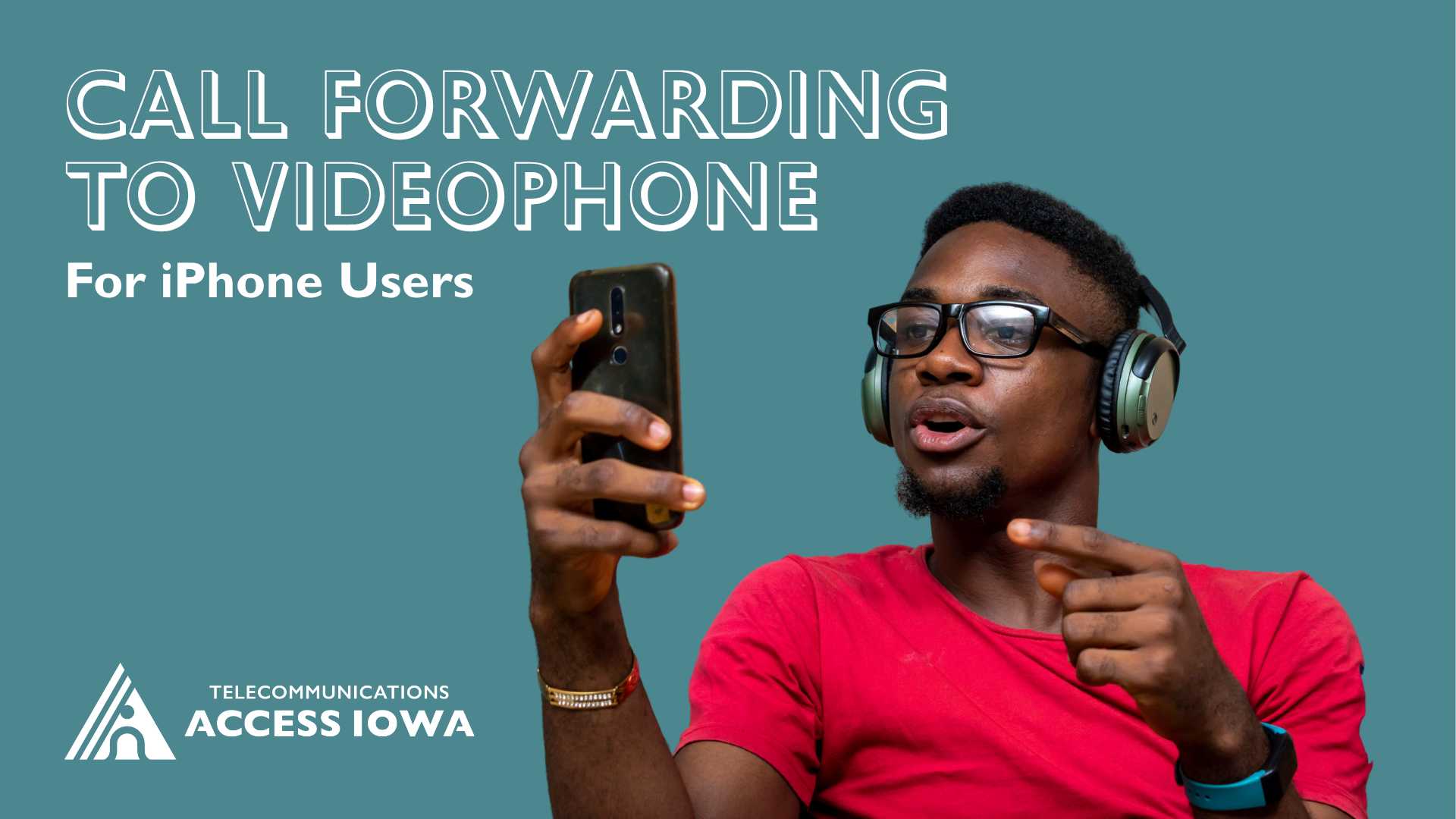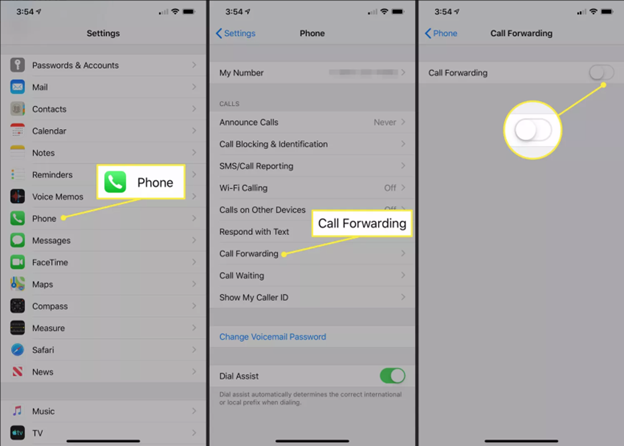iPhone Accessibility Tip: Forwarding Calls to Your Videophone
At Telecommunication Access Iowa (TAI), our mission is to help Iowans who are Deaf, hard of hearing, or have speech difficulties stay connected with the people and services that matter most. Whether it’s through specialized telecommunications equipment or helpful tips for using everyday technology, we’re here to make telecommunication more accessible.
One useful feature we’d like to highlight today is call forwarding on iPhones, a simple setting that can make a big difference for individuals who uses American Sign Language (ASL) and rely on videophones (VPs) for communication.
Call Forwarding
If you use an iPhone for texting and have a separate VP number for video calls, you can turn on call forwarding so that incoming calls to your iPhone number are automatically sent to your VP. This ensures you won’t miss important calls from businesses, service providers, or family members, even if they dial your mobile number instead of your VP.
Once call forwarding is set up, those calls will go through the relay service linked to your VP, allowing you to receive them just like any other VP call. It’s a simple way to stay connected using multiple communication tools on one device, especially for ASL users who prefer video over voice communication.
This feature is especially helpful for those who use ASL and prefer video communication over voice calls.
Why It’s Helpful
Many Deaf and hard-of-hearing individuals have experienced the frustration of missed calls. Whether it’s a doctor’s office trying to confirm an appointment, a delivery service needing instructions, or a family member reaching out, these calls often go unanswered. Not because of neglect, but because the format isn’t accessible.
Voice calls can be inaccessible or ineffective for those who communicate primarily through ASL or other visual means. Even with captioning apps, the experience may not be ideal for every user. That’s where videophones come in for users who rely on ASL. They allow for real-time, visual communication using ASL through a sign language interpreter, making conversations more natural and inclusive.
By forwarding calls from your iPhone to your VP, you ensure that all incoming calls are routed to a platform and format that works best for you. It’s a small adjustment that can lead to greater independence, fewer missed opportunities, and better communication.
How to Set It Up
Setting up call forwarding on your iPhone is quick and easy. Here’s how:
- Open the Settings app on your iPhone.
- Scroll down and tap Apps.
- Scroll down and tap Phone.
- Tap Call Forwarding.
- Toggle the switch to enable it.
- Enter your videophone number.
Once this is done, any calls to your iPhone number will be automatically forwarded to your VP. You can disable or change this setting at any time.
Note: Call forwarding may depend on your carrier and plan. If you don’t see the option in your settings, contact your mobile provider for assistance.
Real-Life Impact
We’ve heard from several users who only discovered the iPhone’s call forwarding feature after experiencing frustrating consequences from missing important voice calls. Many individuals who are Deaf and use ASL who rely primarily on their videophones (VPs) for communication don’t typically answer standard voice calls through the Phone app, which can lead to missed opportunities and delays.
One individual shared a particularly impactful story. They had missed multiple calls from an appliance store that was trying to schedule a delivery. Because they weren’t aware the store was calling and didn’t answer voice calls, the store assumed they were unreachable and canceled the delivery altogether. This created a major inconvenience.
To resolve the issue, the individual had to manually call the store back using their VP. Unfortunately, the next available delivery date was several weeks later, which caused a significant delay in receiving essential appliances they had already purchased.
After learning about and enabling the call forwarding feature on their iPhone, they were able to route voice calls directly to their VP. This simple adjustment allowed them to stay connected, avoid missed calls, and prevent similar delays in the future. It’s a small change that can make a big difference in ensuring accessibility and timely communication.
Others have found that this feature gives their family members more ways to reach them. Whether it’s a spouse, parent, or child, having multiple accessible communication channels can strengthen relationships and reduce misunderstandings.
TAI’s Role in Supporting Accessibility
At TAI, we don’t just provide equipment, we provide solutions. Our wireless program offers smartphones and tablets pre-loaded with accessibility apps tailored to each user’s needs. These include:
- Video Relay Service (VRS) apps like Sorenson nTouch, Purple P3, Z5 Mobile, and Convo.
- Captioning apps like CaptionMate, ClearCaptions, and Hamilton CapTel.
- Speech assistance apps for individuals with speech difficulties.
These tools empower users to communicate in the way that works best for them—whether that’s through ASL, captioned calls, or speech-generating devices.
We offer vouchers that cover up to 95–99% of the cost of eligible equipment, making accessibility affordable and attainable for Iowans across the state.
Who Can Benefit from Call Forwarding?
This tip is especially useful for:
- Iowans who are Deaf using ASL and prefer videophone communication.
- Individuals who are Hard-of-hearing who use captioned phones but still receive calls on their mobile number.
If you’re someone who uses both a smartphone and a VP, this feature can help ensure that your calls reach you in the format you prefer.
Additional Tips for Staying Connected
Here are a few more ways to enhance your communication experience:
- Use VRS apps on your wireless devices to make and receive video calls on the go.
- Enable notifications for missed calls and messages so you never miss an important update.
- Sync your contacts across devices to make calling easier.
- Explore captioning apps if you prefer reading conversations in real time.
- Reach out to TAI for help choosing the right equipment and apps for your needs.
Need Help? We’re Here for You!
If you’re unsure how to set up call forwarding or want to learn more about videophone options, our team is ready to assist. We can walk you through the process, help you choose the right equipment, and make sure your communication setup is working for you.
Visit www.teleiowa.com to learn more about our programs, apply for a voucher, or contact us directly.
Telecommunication Access Iowa is proud to support Iowans in achieving barrier-free communication. Whether it’s through tips like this or through our wireless and traditional equipment programs, we’re committed to helping you stay connected your way!


